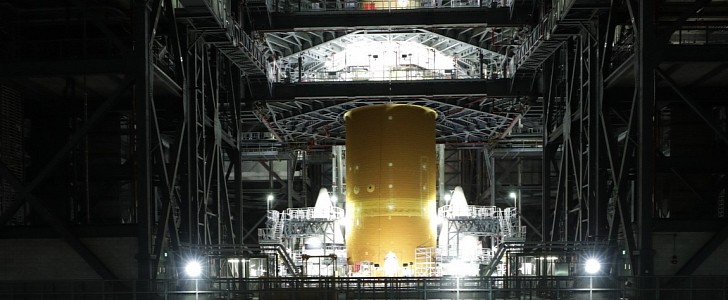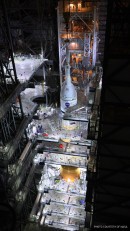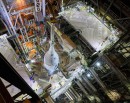NASA's getting closer to launching a new era of space exploration. We're now seeing for the first time the Orion spacecraft on top of the fully assembled Space Launch System (SLS) rocket at the agency's Kennedy Space Center in Florida. Measuring 322 feet (98 meters) high, this beast is undergoing final preparations for the Artemis I uncrewed mission around the Moon.
This mega-Moon rocket will be the primary launch vehicle for NASA's deep space exploration missions, including the Artemis program's planned lunar flights and possible future human journeys to Mars.
The first flight of NASA's newly stacked Moon rocket will be uncrewed. It will take off from the agency's Kennedy Space Center in Florida, accelerating fast enough to give Orion the big push it needs to leave Earth's orbit and travel around 39,000 miles (64 000 km) beyond the Moon.
Orion will spend more time in space than any other spacecraft has done without docking with a space station. The mission will come to an end after nearly three weeks, and a total distance traveled of more than 1.3 million miles (2 million km), with testing Orion's capability to safely return to Earth.
The next step for NASA engineers is to conduct integrated tests of Orion and SLS and ground equipment in preparation for the big event. The team will then run final checks ahead of the mega-Moon rocket's maiden flight.
The initial launch date was set for 2016, but it has already been pushed back several times by now, adding more than five years to the original six-year timeline. On Friday, October 22nd, the agency announced that the first launch is slated for no sooner than February 12th, 2022.
If everything goes as planned, the Artemis II will follow in 2023, and this time it will carry astronauts around the Moon but not actually put them on the lunar surface. That will happen with Artemis III in 2024, and it will mark the first crewed lunar landing since Apollo 17 in 1972.
The first flight of NASA's newly stacked Moon rocket will be uncrewed. It will take off from the agency's Kennedy Space Center in Florida, accelerating fast enough to give Orion the big push it needs to leave Earth's orbit and travel around 39,000 miles (64 000 km) beyond the Moon.
Orion will spend more time in space than any other spacecraft has done without docking with a space station. The mission will come to an end after nearly three weeks, and a total distance traveled of more than 1.3 million miles (2 million km), with testing Orion's capability to safely return to Earth.
The next step for NASA engineers is to conduct integrated tests of Orion and SLS and ground equipment in preparation for the big event. The team will then run final checks ahead of the mega-Moon rocket's maiden flight.
The initial launch date was set for 2016, but it has already been pushed back several times by now, adding more than five years to the original six-year timeline. On Friday, October 22nd, the agency announced that the first launch is slated for no sooner than February 12th, 2022.
If everything goes as planned, the Artemis II will follow in 2023, and this time it will carry astronauts around the Moon but not actually put them on the lunar surface. That will happen with Artemis III in 2024, and it will mark the first crewed lunar landing since Apollo 17 in 1972.
Time lapse footage of the @NASA_Orion stacking is here! ????
— NASA's Exploration Ground Systems (@NASAGroundSys) October 22, 2021
Watch as teams at @NASAKennedy make history with the addition of the spacecraft atop the @NASA_SLS rocket, completing assembly for @NASAArtemis I. pic.twitter.com/pG7ePSE9Wb






